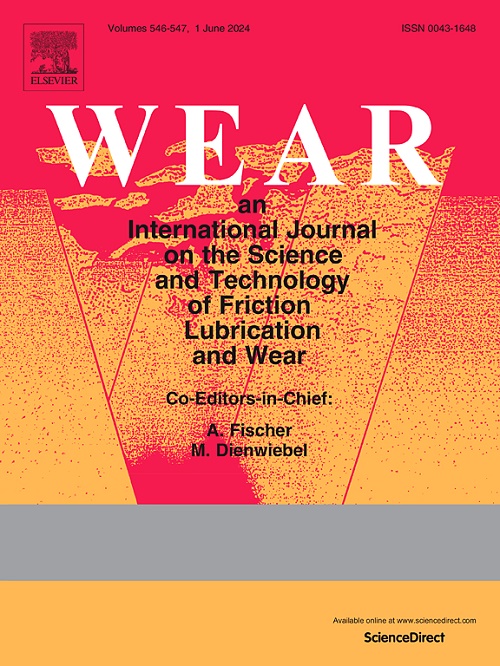Study on microstructure and sliding wear behavior of similar and dissimilar welded joints produced by laser-arc hybrid welding of wear-resistant steels
IF 5.3
1区 工程技术
Q1 ENGINEERING, MECHANICAL
引用次数: 0
Abstract
Welded joints of wear-resistant steel often experience wear problems due to a lack of strengthening particles. This study investigates the wear behavior of welded joints produced by laser-arc hybrid welding (LAHW) on wear-resistant steel with low strength (WRL) and high strength (WRH). The microstructure, wear rate, wear track morphology, and profile were analyzed. The experimental results indicate that the microstructures of the fusion zone (FZ), coarse-grain heat-affected zone (CGHAZ), fine-grain heat-affected zone (FGHAZ), and intercritical heat-affected zone (ICHAZ) in both similar and dissimilar welded joints consist of martensite, coarsening martensite, martensite + ferrite, and martensite + ferrite + bainite, respectively, regardless of WRL and WRH. The wear resistance of the FZ was weaker than those of both WRL and WRH. The wear direction, namely parallel or perpendicular to the welded seams, affects the wear behavior. The cross-sectional areas of the wear tracks in both similar and dissimilar welded joints showed minimal changes in the HAZ and FZ. The wear mechanisms in the different HAZs varied due to microstructural differences.
耐磨钢激光-电弧混合焊接产生的同类和异类焊点的微观结构和滑动磨损行为研究
由于缺乏强化颗粒,耐磨钢的焊点经常出现磨损问题。本研究探讨了低强度(WRL)和高强度(WRH)耐磨钢通过激光-电弧混合焊接(LAHW)产生的焊点的磨损行为。对焊点的微观结构、磨损率、磨损痕迹形态和轮廓进行了分析。实验结果表明,无论 WRL 和 WRH 如何,同类和异类焊点的熔合区(FZ)、粗晶粒热影响区(CGHAZ)、细晶粒热影响区(FGHAZ)和临界热影响区(ICHAZ)的显微组织分别由马氏体、粗化马氏体、马氏体 + 铁素体和马氏体 + 铁素体 + 贝氏体组成。FZ 的耐磨性弱于 WRL 和 WRH。磨损方向,即与焊缝平行或垂直,会影响磨损行为。同类和异类焊点的磨损痕迹横截面积在 HAZ 和 FZ 上的变化都很小。由于微观结构的不同,不同热影响区的磨损机制也各不相同。
本文章由计算机程序翻译,如有差异,请以英文原文为准。
求助全文
约1分钟内获得全文
求助全文
来源期刊

Wear
工程技术-材料科学:综合
CiteScore
8.80
自引率
8.00%
发文量
280
审稿时长
47 days
期刊介绍:
Wear journal is dedicated to the advancement of basic and applied knowledge concerning the nature of wear of materials. Broadly, topics of interest range from development of fundamental understanding of the mechanisms of wear to innovative solutions to practical engineering problems. Authors of experimental studies are expected to comment on the repeatability of the data, and whenever possible, conduct multiple measurements under similar testing conditions. Further, Wear embraces the highest standards of professional ethics, and the detection of matching content, either in written or graphical form, from other publications by the current authors or by others, may result in rejection.
 求助内容:
求助内容: 应助结果提醒方式:
应助结果提醒方式:


